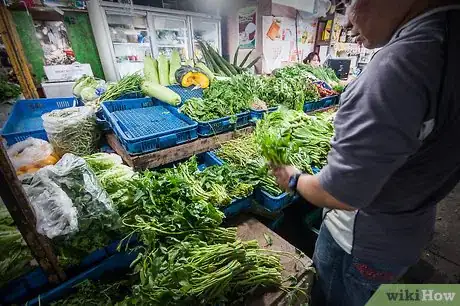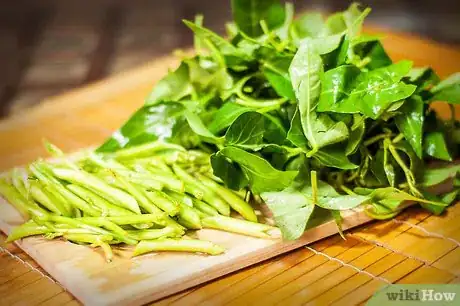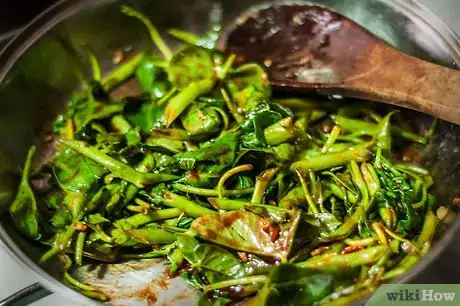wikiHow is a “wiki,” similar to Wikipedia, which means that many of our articles are co-written by multiple authors. To create this article, 13 people, some anonymous, worked to edit and improve it over time.
This article has been viewed 105,445 times.
Learn more...
Kang Kong, (Ipomoea aquatic or swamp mold) is a delicious and mild tasting plant common to Southeast Asia. Also known as water spinach, ong choy, swamp cabbage, phak bung, hung tsai or rau muong, its common to the cuisines of Southeast and East Asia and is commonly found in many Asian groceries as a very cost effective vegetable.
This tutorial looks at how to select, prepare and serve delicious Kang Kong at your next Asian themed dinner, or any time as a quick and easy side dish.
Steps
-
1Purchase your Kang Kong. It's typically sold by the bunch and one bunch is enough to serve 2 for a light meal. Ideally it should be freshly harvested. Look for leaves that are fresh and pert, not wilted or wind damaged. The hollow stems should show signs of being freshly cut and are crisp, stems that were cut the day before tend to dry at the base.[1]
-
2Remove the leaves and cut the stems into 5cm / 2 inch portions with a diagonal cut to make them attractive. The stems require longer cooking time than the leaves.Advertisement
-
3Cook or serve your Kang Kong according to some of the following suggestions:
- As a stir fry: Heat a wok and add 1 tablespoon of oil. When hot, add 1 tablespoon of minced garlic 2 chopped red or green chillies (to taste) and 1 teaspoon minced ginger. Stir fry until the garlic is golden and fragrant - do not burn the spices. Add the Kang Kong stems and stir fry for 2 minutes, then add the leaves. Add 1 tablespoon of hoisin, barbecue or oyster sauce and add a little soy sauce to taste. Garnish with chilli slices or toasted sesame seeds. (Serves 2).[2]
- Stir fry as per the above suggestion with ginger and garlic and include some fried firm tofu or egg noodles to the wok, coating with the sauce.[3] This will bulk the recipe out to make it more of a central meal than as a side dish.
- As a soup: Warm a saucepan with a little oil and gently stir fry a chopped chilli, 1 teaspoon of minced ginger and garlic. Add stock or broth (about 1.5 cups per person) and heat until simmering. Add tamarind paste to taste (about 1 teaspoon for two is mild) and add the Kang Kong stems, 2 sliced spring onions / scallions, a sliced pickled bamboo shoot and a small bunch of mustard greens. Cook until the vegetables are just tender. Serve this soup hot, garnished with Vietnamese coriander, Thai basil and / or Vietnamese mint. (Serves 2).[4]
- As a salad: Wash the Kang Kong and prepare with the leaves and stems separately. In a small bowl, prepare the dressing - mix the juice of 1 lime, 1 chopped chilli, 1 tablespoon of fish sauce, 1 tablespoon of palm sugar and minced garlic to taste. Balance the flavours to your taste to have a combination of sweet, sour, salt and spice. Mix 2 cups of shredded green papaya, a thinly sliced tomato, the kang kong and the dressing and serve, garnished with some toasted crushed peanuts.[5]
-
4Serve immediately. Kang Kong has a wide variety of other uses such as being added into curry sauces, as a soup vegetable or added at a later stage into any stir fry.
References
- ↑ https://www.cookinglight.com/recipes/stir-fried-water-spinach-garlic
- ↑ https://panlasangpinoy.com/kangkong-oyster-sauce-recipe/
- ↑ https://www.kawalingpinoy.com/kangkong-and-tofu-with-oyster-sauce/
- ↑ https://www.angsarap.net/2016/01/29/spicy-salmon-belly-and-kangkong-soup/
- ↑ https://www.mamasguiderecipes.com/2019/07/11/kangkong-salad/





















































